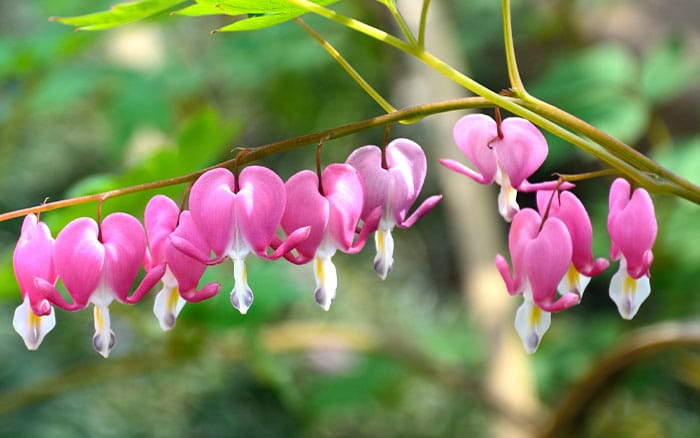Bleeding hearts are easy to grow and mainly trouble free. They get their common name from the fact that the flowers resemble tiny hearts hanging from delicate looking, arching stems.
Roots of the plant are said to help ease pain from sprains and bruises. Native Americans used the plant to cure coughs, bee stings and stomach aches.
What is the botanical name for bleeding heart?
The botanical name for this lovely flower is Lamprocapnos formosa (formerly Dicentra) in the poppy family Papaveraceae.
What are the common names for bleeding heart?
The more common names you will find for Lamprocapnos are Bleeding heart and Chinaman’s breeches.
Where are bleeding hearts native to?
Native to northern China, Japan and North America, the species Lamprocapnos spectabilis was discovered in China by Scottish plant hunter Robert Fortune, and brought back to the UK in 1846 after fighting off bandits and pirates!

What does bleeding heart look like?
Mound forming, deciduous plants, with mid-green, fern-like divided leaves. And they have sprays of delightfully dainty, heart-shaped flowers which dangle prettily from arching stems.
Flower colours range from deep cherry-red to shades of soft pink and white.



Where does bleeding heart like to grow?
Bleeding heart plants grow best when planted in light shade, making them the ideal choice for woodland areas. They will tolerate sun but only grow well in those conditions if the soil is reliably moist, but not waterlogged, and year round temperatures are not too high.
How do you grow bleeding heart successfully?
They are generally easy and trouble free to grow and, to help them establish quickly it’s a good idea to add some leaf mould to the soil before planting as this mimics the woodland floor conditions the plants like to grow in.
Once planted, avoid moving the plant as their roots stretch for long distances and are brittle meaning they break easily making it more difficult for the plant to re-establish easily.

Is bleeding heart good for pollinators?
They are not generally known to attract pollinating insects.
How to choose the right bleeding heart for your garden?
There are around 17 species of Lamprocapnos of which L. spectabilis is the most commonly found in the U.K.
As most bleeding heart plants like to grow in the same conditions, and tend to be of a similar height and spread, it’s mainly a case of choosing varieties whose colour flowers you like best.
They are all mainly trouble free if grown in shady areas in cool, humus-rich soil that remains moist.
How big will my bleeding heart get?
Plants on average tend to grow to a height and spread of between 40cm x 50cm making them a good choice for middle of a shady border.

When to plant bleeding hearts?
Although container grown plants can be planted at any time of the year, (as long as the soil is not frozen or waterlogged), Bleeding hearts establish best when planted in early spring after all danger of frost has passed and whilst the plant is still dormant.
How to care for them?
The leaves on bleeding heart plants start to die back after flowering as, unlike most other herbaceous plants, they become dormant during the summer, not the winter. Fading leaves can be hidden well if surrounded with plants that provide summer interest such as Gillenia trifoliata (Bowman’s root) or low growing evergreen shade lovers, such as Pachysandra terminalis (Japanese spurge).
If planted in soil that stays reliably moist additional watering should not be necessary.
They do not have any special feeding requirements.
How do I keep my bleeding heart looking good?
A few weeks after flowering the leaves of bleeding hearts will start to die down. Wait until the leaves wilt and turn yellow before removing them, cutting down to ground level.
How do I propagate bleeding heart?
Make more plants by dividing well-established clumps in either early spring when the leaves appear, or late summer after the leaves have died down.
Alternatively take root cuttings of well-established plants during the winter months.
What problems can bleeding heart have?
The most found problem in Asters is powdery mildew. You can purchase mildew-resistant varieties, and you may find Symphotrichum novi-belgii Asters to be the most vulnerable. When watering, avoid spraying the leaves. Try to grow your Asters in moisture-retentive soil if you can and ensure the soil doesn’t dry out.
Within six to eight weeks, you should see signs of growth from your cuttings. At this point, you can pot your cuttings into their own individual containers. Then, plant them out in spring. You should see flowers from them the following year.
What varieties should you look out for?
Here are some great bleeding hearts to grow at home for different parts of the garden:

‘Valentine’ is a gorgeous bi-coloured flower variety with cherry-red outer petals and white inner petals.

‘King of Hearts’ is an incredibly long-flowering plant, flowering from May all the way up to October. It has small clusters of perfect heart-shaped, rich-pink flowers held on slender stems above a mound of handsome, lacy, grey-green leaves.

‘Alba’ produces pure white, heart-shaped flowers, making it a great choice for lightening shady areas and formosa is the perfect choice for soft pink flowers.
When should I buy bleeding heart?
The best time to buy bleeding heart plants is from garden centres and plant nurseries during the spring.
Which garden design styles do bleeding heart work best in?
Bleeding hearts look wonderful in an informal, cottage garden, shady or woodland border setting. They can also be planted under and around shrubs and roses if the soil remains reliably moist.
Lamprocapnos are wonderful and classic additions to your garden borders, with their delicate blooms adding a magical touch.

Leave A Comment